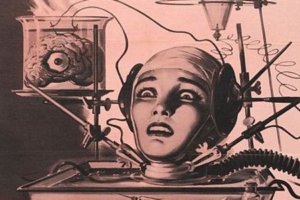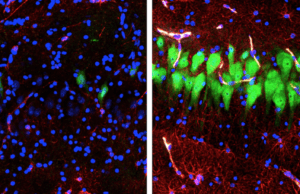But I thought about the pilot episode of Star Trek.
Pigs have long been models in cardiovascular disease research, because their hearts and blood vessels are about the same size as ours. My favorite experimental pig, though, lent her liver.
Sweetie Pie had been genetically modified so that her cells were festooned with human proteins, preventing organ rejection. In 1997, when she was 15 weeks old, her detached but functioning liver kept 19-year-old Robert Pennington, suffering from acute liver failure and desperately needing a transplant, alive for 6.5 hours. The young man’s blood was cleansed outside of his body through Sweetie Pie’s living liver until a human one became available.
 Pigs mixing with humanity figure into sci-fi and even comedy. The 1960 Twilight Zone episode “Eye of the Beholder” visited a society in which people have pig faces, and the few with human faces are condemned to live out their lives out of sight in their own villages. And on Seinfeld, Kramer reported a pig man on the loose on the top floor of a hospital.
Pigs mixing with humanity figure into sci-fi and even comedy. The 1960 Twilight Zone episode “Eye of the Beholder” visited a society in which people have pig faces, and the few with human faces are condemned to live out their lives out of sight in their own villages. And on Seinfeld, Kramer reported a pig man on the loose on the top floor of a hospital.
Introducing BrainEx
The title of the Nature paper says it all: “Restoration of brain circulation and cellular functions hours post-mortem.”
The findings challenge the long-held belief that brain function irreversibly spirals down after a few minutes without oxygen. Nenad Sestan, MD, PhD, professor of neuroscience, comparative medicine, genetics and psychiatry and executive director of the genome editing center at Yale, headed the team (no pun intended).
The researchers used a device they named BrainEx, the “ex” referring to “ex vivo,” an intermediate between inside the body (in vivo) and outside in glassware (in vitro). The specs in the paper depict a labyrinth of filters and pumps, a computer interface, a vat of stuff, a chiller, a gas source, an oxygenator, a pulse generator and a heat exchanger, to which a carefully peeled pig brain is attached.
Perfusing the byways of BrainEx is a fake blood-like concoction. It includes an oxygen-carrying protein like hemoglobin but not contained in cells, anti-clotting factors, protectants, nutrients, water, drugs, and agents to prevent swelling and render the doctored brain visible on an ultrasound scan.
The 32 brains came from 6- to 8-month-old pigs from a meat processing plant and were removed from their skulls. Pig brains are otherwise discarded or, in some cultures, served as a delicacy called offal (here are some recipes).
The brains were collected four hours after death and perfused in BrainEx for six hours.
 At the cellular level, it isn’t good for a mammal’s brain to be separated from the rest of the body. Cell membranes lose their charge and can no longer pump various things in and out. Mitochondria malfunction, switching metabolism to anaerobia. Glutamate builds up to toxic levels. All of this heralds what the researchers call “a progressive, and largely irreversible, cascade of apoptosis, necrosis, and axonal damage.”
At the cellular level, it isn’t good for a mammal’s brain to be separated from the rest of the body. Cell membranes lose their charge and can no longer pump various things in and out. Mitochondria malfunction, switching metabolism to anaerobia. Glutamate builds up to toxic levels. All of this heralds what the researchers call “a progressive, and largely irreversible, cascade of apoptosis, necrosis, and axonal damage.”
But wait!
Neurons in brains can be coaxed to survive in glassware even hours after the oxygen supply has been cut off, and their mitochondria remain on the job of extracting energy from nutrients. And apparently the brains of cats and macaques can recover even after an hour without oxygen, as do some people who survive extreme and prolonged hypothermia, such as by falling through ice.
With these examples in mind, the researchers hypothesized an “underappreciated capacity” of an oxygen-starved mammalian brain to survive, even though organ slices used in research typically remain alive only for seconds or minutes.
The findings
The pig brains hooked up to BrainEx didn’t do anything approaching thinking – the electroencephalograms depicting electrical activity were flat. But other things happened, indicating perhaps an inkling of brain function:
- Cell death slowed.
- The protein scaffolds of the cytoskeleton persisted, maintaining some cellular architecture.
- Blood vessels pulsated, circulating the fake blood.
- Cells of the cerebrum metabolized. Even without electrical signals, something was going on.
- Glial cells retained the ability to spark inflammation.

Most exciting, synapses in the hippocampus indicated transmission of neural messages. Were memories alive, although the pig was not? Hold that thought.
Apparently, a brain needn’t function at the organ level to keep doing so at the cellular level. Had BrainEx been available in Oz, the coroner might never have declared “As Coroner, I must aver I thoroughly examined her. And she’s not only merely dead, She’s really, most sincerely dead.”
The Yale researchers call BrainEx “a new class of tools” to bridge basic neuroscience and clinical research. The question of consciousness after decapitation actually goes back centuries, to observations on the newly-guillotined.
The guillotine was intended to provide a swifter demise than other methods of decapitation. But did neural activity nonetheless linger? According to “8 Things You Might Not Know About the Guillotine”:
“The debate reached new heights in 1793, when an assistant executioner slapped the face of one of his victims’ heads and spectators claimed to see its cheeks flush in anger. Doctors later asked the condemned to try to blink or leave one eye open after their execution to prove they could still move, and others yelled the deceased’s name or exposed their heads to candle flames and ammonia to see if they would react. In 1880, a doctor named Dassy de Lignieres even had blood pumped into the head of a guillotined child murderer to find out if it would come back to life and speak.”
Two Commentaries in Nature, and the wide media response, indicate that the new report has raised many questions and concerns.
From organ donation to brain resuscitation?
The ability to keep some brain function for hours after oxygen deprivation could impact the disturbing situation in which a medical team in the operating theater must decide whether to resuscitate the patient — or ready the organs for transplant.
Two bioethicists from Case Western Reserve University School of Medicine, Stuart Youngner and Insoo Hyun, addressed this in “Pig experiment challenges assumptions around brain damage in people.” If we can bypass the heart and lungs, they argue, can we bypass the brain?
“The assumptions have always been that after a couple of minutes of anoxia, or no oxygen, the brain is ‘dead.’ The system used by the researchers begs the question: How long should we try to save people?” said Dr. Youngner.
 The commentary creepily mentions that in some nations, organ recovery teams use a balloon to cut off blood circulation to the brain after declaring a person dead based on the heart and lungs no longer functioning. With the new information, “it could become harder for physicians or family members to be convinced that further medical intervention is futile,” Youngner and Hyun write.
The commentary creepily mentions that in some nations, organ recovery teams use a balloon to cut off blood circulation to the brain after declaring a person dead based on the heart and lungs no longer functioning. With the new information, “it could become harder for physicians or family members to be convinced that further medical intervention is futile,” Youngner and Hyun write.
Said Youngner, “As we get better at resuscitating the brain, we need to decide when are we going to save a patient, and when are we going to declare them dead—and save five or more who might benefit from an organ.” That comment seems to me more a value judgment than a sound medical decision plan.
In a second commentary, “Part-revived pig brains raise ethical quandaries,” bioethicists and lawyers Nita A. Farahany and Charles M. Giattino from Duke University and Henry T. Greely from Stanford University write that the new work “opens up possibilities that were previously unthinkable.”
Their concern is consciousness. Did the BrainEx environment dampen some neural activity that might appear or revive under other conditions?
The Yale researchers didn’t break any laws regarding experimental animal welfare, Farahany, Giattino, and Greely emphasize, because clearly the headless pigs had died, plus they had been destined to become pork. The trio suggests five guidelines for working with disembodied mammal brains, quoting Billy Crystal in the 1987 film The Princess Bride: “There’s a big difference between mostly dead and all dead. Mostly dead is slightly alive.”
Their five suggestions:
- Develop ways to detect consciousness and sentience
- Decide which species are the best to study
- Be certain that there is no pain. They suggest more work on rodents, but why not ask folks who kill chickens and observe the separated heads?
- Explore use of anesthetics
- Determine how long BrainEx and similar systems can and should run
They suggest that the technique, once thoroughly investigated, might be used to bring back brains damaged from lack of oxygen, assuming the rest of the body remains attached. Or, revive intentionally frozen brains, like that of Ted Williams.
But most exciting is what something like BrainEx might do for those living with impaired memory, because of the awakening neurons in the hippocampus. Such an intervention could be devastating for someone with PTSD, but miraculous for someone with Alzheimer’s.
“Various groups are developing ways to decode the neural activity of living people, for instance to probe their memories or the images they have seen in their dreams. Could such approaches one day be applied to brains after death? Such possibilities (if they come to pass at all) are far in the future,” they write.
And that brings me back to Star Trek and the unforgettable Captain Pike.

The final frontier
The pilot to the Star Trek franchise, The Cage, was rejected but then subsumed into “The Menagerie,” an episode with James T. Kirk at the helm of the U.S.S. Enterprise.
The year is 2267, and original captain Christopher Pike has been severely injured during a rescue mission. He’s paralyzed, scarred, and unable to speak, but he can direct his brainwaves to turn a light on, one flash signaling “yes,” two flashes “no.”
Captain Pike may appear damaged to others, but in his mind, he’s whole, and enjoying an alternate, healthy, and fulfilling existence, complete with sensation and perception, thanks to technology that taps into his brain cells.
The humanoids of Talos IV had initially deployed their technology to lure the Enterprise to rescue their captain, but when they observe Pike’s joy, they invited him to stay, “unfettered by his natural body.” In the final scene, Captain Pike, in his mind, cavorts with the beautiful Vina, who is actually an old decrepit woman also enjoying a renaissance of her youth.
The fictional and futuristic Captain Pike is a far cry from the real 32 disembodied pickled pig brains with signs of reawakening hippocampi. But he illustrates the uniqueness of the brain. It is different from, say, a spleen or a gallbladder or even a heart, which is more or less a mechanical pump.
The patterns of synapses in a brain connecting the neurons into intricate networks hold the very essence of self, of being. I’m uneasy with what the elegant new study on the pig brains may have unleashed.
Ricki Lewis is the GLP’s senior contributing writer focusing on gene therapy and gene editing. She has a PhD in genetics and is a genetic counselor, science writer and author of The Forever Fix: Gene Therapy and the Boy Who Saved It, the only popular book about gene therapy. BIO. Follow her at her website or Twitter @rickilewis































